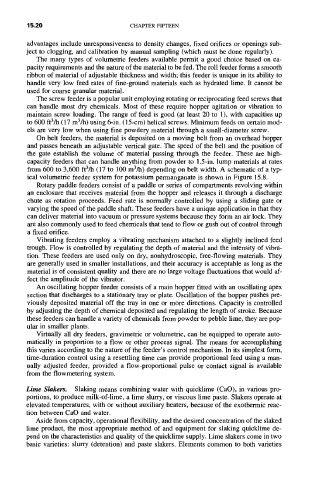Page 512 -
P. 512
15.20 CHAPTER FIFTEEN
advantages include unresponsiveness to density changes, fixed orifices or openings sub-
ject to clogging, and calibration by manual sampling (which must be done regularly).
The many types of volumetric feeders available permit a good choice based on ca-
pacity requirements and the nature of the material to be fed. The roll feeder forms a smooth
ribbon of material of adjustable thickness and width; this feeder is unique in its ability to
handle very low feed rates of fine-ground materials such as hydrated lime. It cannot be
used for coarse granular material.
The screw feeder is a popular unit employing rotating or reciprocating feed screws that
can handle most dry chemicals. Most of these require hopper agitation or vibration to
maintain screw loading. The range of feed is good (at least 20 to 1), with capacities up
to 600 ft3/h (17 m3pa) using 6-in. (15-cm) helical screws. Minimum feeds on certain mod-
els are very low when using fine powdery material through a small-diameter screw.
On belt feeders, the material is deposited on a moving belt from an overhead hopper
and passes beneath an adjustable vertical gate. The speed of the belt and the position of
the gate establish the volume of material passing through the feeder. These are high-
capacity feeders that can handle anything from powder to 1.5-in. lump materials at rates
from 600 to 3,600 ft3/h (17 to 100 m3/h) depending on belt width. A schematic of a typ-
ical volumetric feeder system for potassium permanganate is shown in Figure 15.8.
Rotary paddle feeders consist of a paddle or series of compartments revolving within
an enclosure that receives material from the hopper and releases it through a discharge
chute as rotation proceeds. Feed rate is normally controlled by using a sliding gate or
varying the speed of the paddle shaft. These feeders have a unique application in that they
can deliver material into vacuum or pressure systems because they form an air lock. They
are also commonly used to feed chemicals that tend to flow or gush out of control through
a fixed orifice.
Vibrating feeders employ a vibrating mechanism attached to a slightly inclined feed
trough. Flow is controlled by regulating the depth of material and the intensity of vibra-
tion. These feeders are used only on dry, nonhydroscopic, free-flowing materials. They
are generally used in smaller installations, and their accuracy is acceptable as long as the
material is of consistent quality and there are no large voltage fluctuations that would af-
fect the amplitude of the vibrator.
An oscillating hopper feeder consists of a main hopper fitted with an oscillating apex
section that discharges to a stationary tray or plate. Oscillation of the hopper pushes pre-
viously deposited material off the tray in one or more directions. Capacity is controlled
by adjusting the depth of chemical deposited and regulating the length of stroke. Because
these feeders can handle a variety of chemicals from powder to pebble lime, they are pop-
ular in smaller plants.
Virtually all dry feeders, gravimetric or volumetric, can be equipped to operate auto-
matically in proportion to a flow or other process signal. The means for accomplishing
this varies according to the nature of the feeder's control mechanism. In its simplest form,
time-duration control using a resettling time can provide proportional feed using a man-
ually adjusted feeder, provided a flow-proportional pulse or contact signal is available
from the flowmetering system.
Lime Slakers. Slaking means combining water with quicklime (CaO), in various pro-
portions, to produce milk-of-lime, a lime slurry, or viscous lime paste. Slakers operate at
elevated temperatures, with or without auxiliary heaters, because of the exothermic reac-
tion between CaO and water.
Aside from capacity, operational flexibility, and the desired concentration of the slaked
lime product, the most appropriate method of and equipment for slaking quicklime de-
pend on the characteristics and quality of the quicklime supply. Lime slakers come in two
basic varieties: slurry (detention) and paste slakers. Elements common to both varieties

